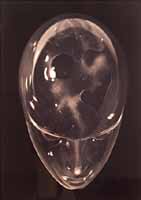|
Untitled (science fiction) (2000)
Digital image 1/15
70 x 50 cm.
If the debate between constructionism and essentialism, the theoretical
perspectives from which the masculinity/femininity binomial has
been analysed, has in recent years tended to favour the former,
over this decade it has also been enriched by a discussion on
the need to abandon the binary oppositions which demonise science
and technology and deify nature. As Donna Haraway says, "I
prefer to be a cyborg than a goddess". The phrase is as
demythifying as it is provocative; for this controversial theorist,
cyberculture questions dualisms, as technology crosses over the
border separating the natural form the artificial. Marina Nunez
is a passionate lover of science fiction cinema and literature,
but also of the Gothic and satirical literature of the eighteenth
and nineteenth centuries, in their critique and rejection of
society. Her drawings and paintings are also fed by these references
and by the art/science interrelationship, specially Enlightment
attempts to situate man in nature through the syntesis of physio-psychological
knowledge. From here, too, comes her interest in not representing
an essential subject but instead variants on the subject of otherness;
otherness and difference are precisely what grammatical gender
is all about. The work, in turn, is based on a solid theoretical
framework; on the displacement of the patriarchal discourse and
the creation of a fictional discourse together with the need
for a space for desire (as put forward by Helene Cixous with
her proposals for looking at fantasy, the unconscious and the
language of the flesh); on the insistence of Irigaray and Kristeva
(situated intertextually with Oerrida, Lacan and others) on the
subject in progress; and on Bakhtin's analysis of the heterogeneous
and the freeing of consciousness through laughter, madness, strangeness.
All this theoretical corpus has led Nunez not only to reject
universal and essentialist ideas, but also to question the "stability
of meaning". This is not possible in the bodies she represents
and the states which invade them: madness, monstrosity, as a
representation of a critique of the values which strengthen homogenisation,
and the control of individuals. With the series painted over
recent years, Marina Nunez explores the difference and the wretchedness
of conditions of subjects which upset the idea of identity and
order. The Monsters, possessed by wires or tumours and ganglions
which invade them, represent women who carry in their bodies
the hybrid - cyborgs, testifying to Haraway's debate on how the
boundary between the self and the other is fading, just like
the dualisms of mate rialismfidealism, mind/body, human/animal,
natural/artificial, thanks to cybernetics. The expression of
those fluid limits is materialised in Monsters, as carriers of
voices and "crushers of limits", as well as offering
resistance to integration with their twisted and torn bodies;
presences which prepare to revive the liberation of the repressed.
Mar Villaespesa & Juan Vicente Aliaga Extract form their
text "Transgeneric@s. Representations and experiences of
society, sexuality and gender in contemporary Spanish art",
in "Transgeneric@s" (catalog), ed. Diputacion de Guipuzcoa,
San Sebastian, Spain 1999.
|

